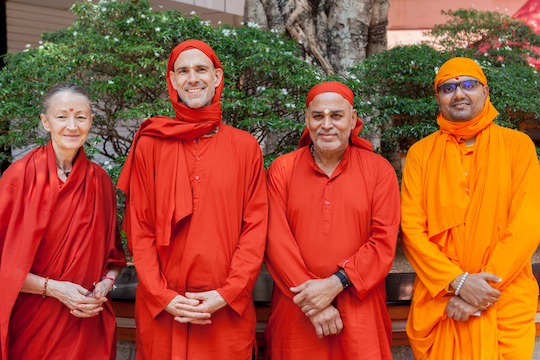Amma initiates 260 monastics to serve the world!

A Sanyasi does not have a particular God. Sanyasi’s life is to serve everyone seeing them as God. Even a Sanyasi’s breath should be for the good of others. - Amma
We are so pleased to announce that Amma’s representatives in North America were initiated into Sanyasa* asrama and Brahmacharya* asrama at a formal ‘diksha’* ceremony officiated by Amma at the Mata Amritanandamayi Math in India on March 13, 2020.
The new names given by Amma are (L to R):
Swamini Ambikamrita Prana,
Swami Shantamritananda Puri,
Swami Dayamritananda Puri, and
Br. Ramanandamrita Chaitanya.
The names are beautiful reminders about the true goal of human life and follow the order of the Adi Shankaracharya Parampara (lineage). The names of the Swamis (male) are suffixed with ‘Ananda’ (bliss) and Puri*. The names of the Swaminis (female) are suffixed with Prana (life breath).
The brahmacharis received new names ending with ‘Chaitanya’, meaning ‘consciousness.’ Over 260 disciples took part in the historic ceremony, which included a series of rituals and penances that symbolized the ultimate sacrifice of their past identity and formalized a new identity as a servant of the world.
Amma lovingly gave each of them their new robes saying: “a Sannyasi is a real servant of the world. In fact, he or she is the one who serves and loves the world without expecting anything in return.” She lovingly requested everyone to pray for them to continue their work of spreading the message of love and service to the world.
It is an enormous honor for North America to welcome back our representative monastic disciples who have so lovingly committed to serving our region and the world at large.
Footnotes
Sanyasa, this word is mentioned for the first time in the Mundaka Upanishad, it is the path of renunciation. A Sanyasi is one who has risen above the mundane ambitions of a householder and also the silence and penance of a recluse. According to the Bhagavad Gita, Sanyasa means relinquishment of actions arising from desires, and Tyaga means relinquishment of fruit of all actions. The sanyasis are eligible to pursue the path of knowledge; they have no need to perform ritual or tend the sacred fire (Brahma Sutra III.iv.25).
Brahmacharya is traditionally regarded as one of the five yamas (ethical rules) in Yoga, as declared in verse 2.30 of Patanjali's Yoga Sutras. It is a form of self-restraint regarded as a virtue, and an observance recommended by the Guru. The great epic Mahabharata describes the objective of brahmacarya as knowledge of Brahman or the Supreme Self.
Diksa is given in a one-to-one ceremony, and typically includes the taking on of a serious spiritual discipline.
Adi Shankaracharya - Adi Shankaracharya was an early 8th century Indian philosopher and theologian who consolidated the doctrine of Advaita Vedanta ( Non-dualistic philosophy). He is credited with unifying and establishing the main currents of thought in Hinduism.
Puri - Adi Shankaracharya reorganised all the Sannyasis in India into ten main groups known as the Dasanami Tradition. These orders are also allocated to different maths. The Sannyasis of Mata Amritanandamayi Math belong to the Puri Sannyasa tradition.
